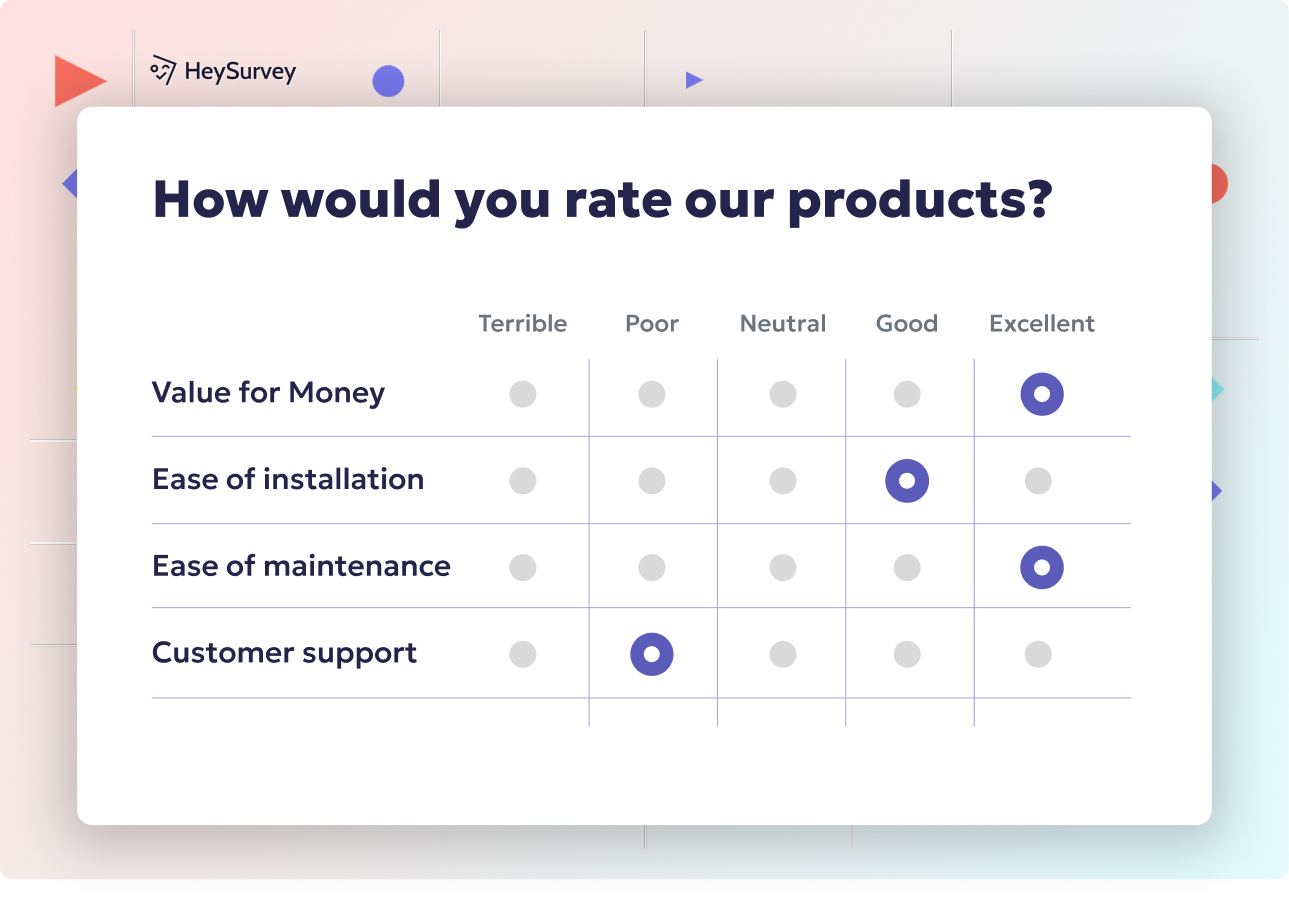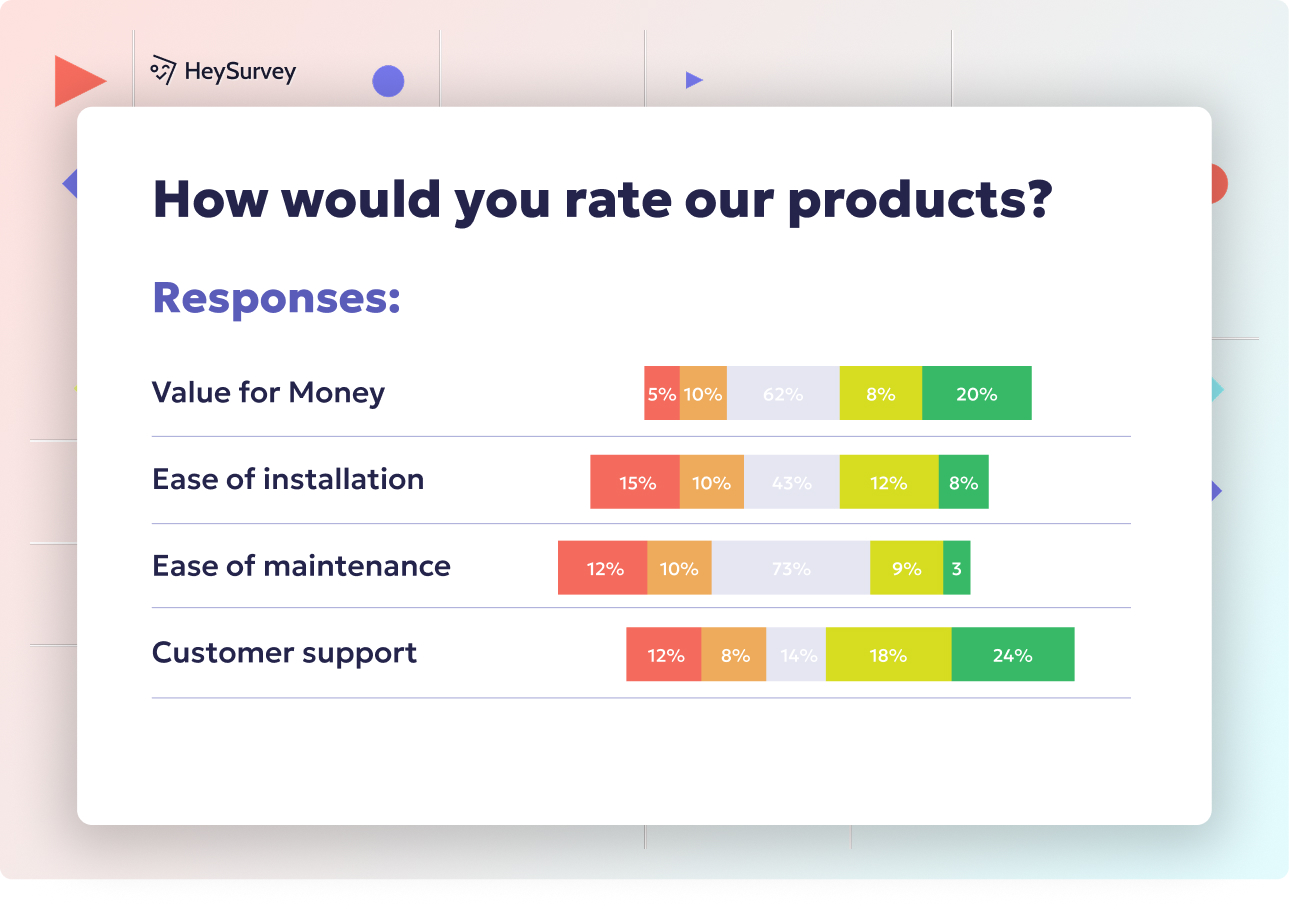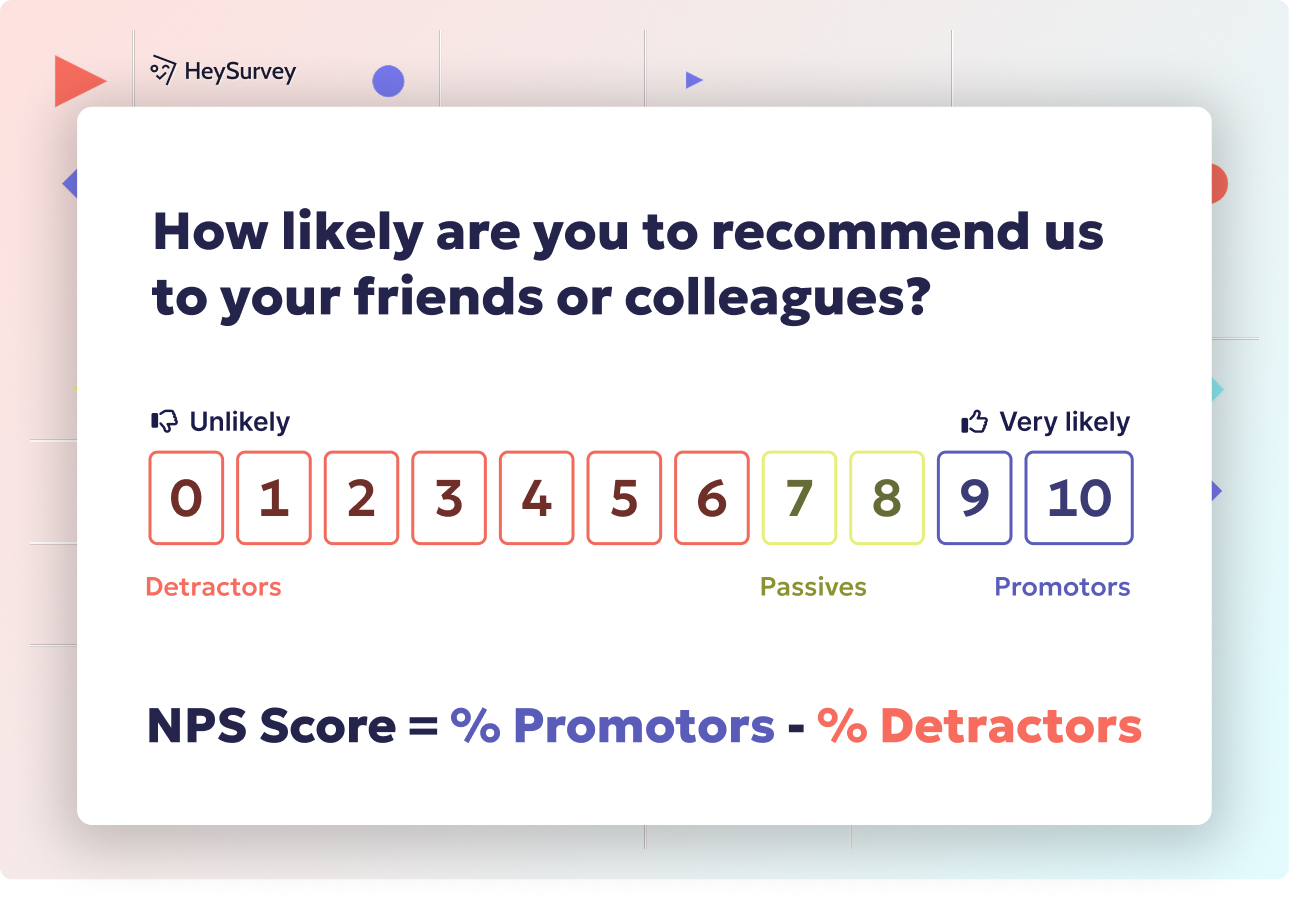31 Innovation Survey Questions to Spark Creativity and Growth
Explore 28 innovation survey questions across 7 types to unlock fresh ideas, improve culture, and accelerate your innovation process effectively.
Innovation surveys act like the secret superpower modern businesses use to thrive. They’re the ultimate way to spark idea generation, spot organizational blind spots, validate risky research, and fast-track creative wins. Companies tap into these surveys at critical moments—before brainstorming, right after launch, or during relentless improvement cycles. Mastering innovation survey questions and innovation feedback isn’t complicated, but it is crucial. In this article, we’ll play tour guide through the seven most important survey types for capturing insight, measuring innovation culture, and unblocking the creative flow.
Ideation & Front-End Innovation Survey
Why and When to Use
The Ideation & Front-End Innovation Survey is a magnet for early-stage, wild ideas before resources get committed. It catches a rush of creative energy from employees, customers, or even the broader community. If your business thrives on staying fresh, you’ll want to run this survey during quarterly ideation sprints, hackathons, or right before annual strategic planning.
Early input ensures you don’t just hear from the usual suspects. By weaving in survey for innovation culture questions, you unlock input from overlooked talent and even external voices. The raw feedback helps spot the unexpected—potential market disruptors, previously ignored pain points, or even dormant internal know-how.
Why is timing so crucial? Launch these surveys:
- Right before resource allocation or an innovation budget meeting
- When you notice ideation fatigue or crowd-pleasing ideas only
- At the kickoff of major projects or innovation challenges
These moments ensure your pipeline is flooded with genuine and bold ideas. Don’t wait for stale thinking to set in!
5 Sample Questions to Include
What unmet customer need do you believe we should solve next?
Which emerging technology could most disrupt our market in the next 3 years?
Describe a process inside our company that feels outdated or inefficient.
If budget were no obstacle, what new product or feature would you build?
How might we repurpose existing assets to create new revenue streams?
When sent at the right time, these questions energize staff and unearth unique opportunities. The responses become the fuel for your next innovation sprints and strategic priorities.
Regularly conducting innovation surveys during strategic planning periods enables organizations to capture current sentiments and emerging trends, fostering continuous improvement in creativity and innovation. (supersurvey.com)

Creating an innovation survey with HeySurvey is straightforward and intuitive—even if you’re a complete newbie. Follow these three easy steps to get your survey up and running quickly. When you're done, you can jump straight into a ready-made template with the button below these instructions!
Step 1: Create a New Survey
- Head to HeySurvey’s home page and select “Create New Survey”.
- Choose whether you want to start from scratch, pick a pre-built template (great for innovation surveys), or use text input creation.
- Give your survey an internal name that helps you easily identify it, like “Employee Innovation Culture Survey” or “Customer Feedback for New Product.”
That’s it—your blank innovation canvas is ready!
Step 2: Add Questions
- Click the “Add Question” button, which is easy to spot at the top or between existing questions.
- Pick your question type—such as Text for open answers, Choice for multiple options, or Scale for rating questions like Likert scales or NPS.
- Type in your question and add descriptions if needed to provide context.
- Mark key questions as required to ensure respondents don’t skip the good stuff.
- Feel free to add images or use formatting (bold, lists, bullet points) to make questions engaging.
- Remember, you can duplicate questions or reorder them to build your perfect flow.
For innovative surveys, mixing qualitative questions with scales is the secret sauce to get both feelings and numbers.
Step 3: Publish Survey
- When you’re happy with your survey draft, hit “Preview” to see exactly how respondents will experience it—on desktop or mobile.
- Tweak design elements anytime using the Designer Sidebar to adjust colors, fonts, backgrounds, or add animations.
- Finally, click “Publish” to make your survey live.
- Share the survey link via email, embed on websites, or post on social media to start collecting those golden innovation insights.
- Keep in mind you’ll need a HeySurvey account to publish and view responses, so make sure you sign up if you haven’t already.
Bonus Steps for Extra Power
- Apply Branding: Upload your company logo and customize colors and fonts via the Designer Sidebar to keep the survey consistent with your brand identity.
- Define Settings: Set survey start/end dates, response limits, or redirect URLs after completion. You can even allow participants to view aggregate results if it suits your purpose.
- Skip into Branches: Use advanced branching options to create smart survey paths—where answers lead respondents to different follow-up questions, making the experience personal and relevant.
And voilà! With these simple steps, your innovation feedback survey will be engaging, branded, and ready to deliver the insights you need. Ready to give it a go? Open a specialized innovation survey template now and start customizing it instantly!
Employee Innovation Culture Survey
Why and When to Use
The soul of organizational innovation isn’t found in tools or tech—it lives in your company’s culture. The Employee Innovation Culture Survey digs deep into the everyday feelings and behaviors that either ignite or douse innovation. It zeroes in on psychological safety, risk-taking, and leadership’s open embrace of new ideas.
Running this survey bi-annually or after big changes (like a reorg or new leadership) gives you fresh readings on your culture temperature. Does your team feel safe to experiment, propose wild alternatives, or even fail? If leadership only praises “safe” wins, you’ll know from the answers.
Use this culture-check survey to catch problems before they snowball:
- After high-profile failures or surprising project cancellations
- When employee suggestion boxes gather digital dust
- When you hear grumblings about “innovation theater” versus real change
Measuring staff sentiment on risk tolerance ensures you build a playground, not a prison, for bright ideas and experimentation.
5 Sample Questions to Include
I feel safe proposing bold ideas without negative consequences. (Likert)
Leadership celebrates experiments—even failed ones—openly. (Likert)
How often do cross-functional teams form to solve problems?
What barriers stop you from experimenting more often?
Rate the adequacy of resources available for testing new ideas.
These questions create a feedback loop and help realign programs or messaging if you notice innovation fatigue or fear of failure creeping in.
A study in Vietnam's IT industry found that organizational culture dimensions—mission, adaptability, and well-being—significantly enhance employee innovation. (emerald.com)
Customer-Driven Innovation Feedback Survey
Why and When to Use
True innovation starts and ends with the customer. The Customer-Driven Innovation Feedback Survey crowdsources powerful feature ideas and helps prioritize your product roadmap based on what matters most to real users, not just the product team. The best time to send this survey is right after a beta release, during user-community gatherings, or at the close of a customer advisory meeting.
Listening to customers directly uncovers friction points, fresh opportunities, and unexpected needs. Doing so is like giving your roadmap a reality check, ensuring your brightest advancements align with customer pains, not just internal hypotheses.
Use this survey when:
- You want to test feature popularity with actual users
- Roadmap prioritization debates get heated
- You want to spark participation in ongoing co-creation programs
Direct customer feedback at critical junctures gives your innovation process the clarity, confidence, and focus it craves.
5 Sample Questions to Include
Which current feature frustrates you the most and why?
Rank these potential improvements by importance.
What brand outside our industry impresses you with innovation?
Describe a task you wish our product could automate.
How likely are you to participate in future co-creation programs?
Your best product ideas are out there—these questions just give them a voice (and a to-do list for your teams!).
Open-Innovation Partner Survey
Why and When to Use
Collaboration is the heartbeat of modern innovation. The Open-Innovation Partner Survey targets external partners like universities, suppliers, or ambitious startups. It’s the ultimate matchmaking tool, helping companies uncover shared interests, identify collaboration models, and gauge strategic fit.
Deploy this survey before joint ventures, co-development sprints, or technology-scouting missions. You’ll avoid wasted energy on misaligned partnerships and accelerate the search for fast “win-win” pilots.
You should use this when:
- Entering talks with research labs or tech incubators
- Planning industry hackathons with external players
- Weighing multiple startup pitches or partnership proposals
Understanding partner alignment up front stops projects from stalling over mismatched goals or IP debates later.
5 Sample Questions to Include
Which of your capabilities align with our strategic priorities?
What collaboration model (licensing, JV, co-development) do you prefer?
Rate our responsiveness during previous partnership discussions.
What IP-sharing concerns do you have?
Suggest joint pilot projects that could deliver quick wins (<6 months).
These questions foster trust and speed, moving partnerships from the talking stage to successful pilots much faster.
Effective open innovation partnerships require assessing partner capabilities, preferred collaboration models, responsiveness, IP concerns, and potential joint projects to ensure strategic alignment. (fastercapital.com)
Post-Launch Innovation Performance Survey
Why and When to Use
The finish line of launch day isn’t the end—it’s just the start of improvement. The Post-Launch Innovation Performance Survey is crucial for measuring how your latest feature, service, or product performs when it finally hits the real world.
Run this survey 30, 60, or 90 days post-launch. It gives immediate feedback about the user experience, the surprises (good and bad), and the lingering gaps that need tackling next. Direct customer responses fuel your continuous-improvement roadmap and shine a spotlight on any deal-breakers before they become headlines.
Send the survey:
- After major product launches or new platform rollouts
- When onboardings spike or churn returns surprise you
- To validate the bold new bets the R&D team made
Real user feedback post-launch means you pivot smartly, making each release better than the last.
5 Sample Questions to Include
How well does the new feature solve the problem it was designed for?
What surprised you (positively or negatively) after using it?
How easy was onboarding compared to your expectations?
What one enhancement would make this product indispensable?
How likely are you to recommend this innovation to peers? (NPS)
Simple, actionable answers keep your team focused and ready to adapt as needed.
Innovation Skills Assessment Survey
Why and When to Use
Every big innovation push needs a serious look at skills gaps. The Innovation Skills Assessment Survey uncovers strengths and weaknesses in design thinking, prototyping, data analysis, and more. Think of it as your innovation team’s skills tune-up before launching heavy R&D or a big up-skilling effort.
Run this at least once a year or before building tailored learning programs. Knowing exactly where the gaps are lets you avoid cookie-cutter training and focus investment where it drives the most change.
Pull this survey out when:
- Launching a design thinking or rapid innovation bootcamp
- Reorganizing product teams around new methods or tech tools
- Reviewing past innovation projects for skill attrition or turnover
Pinpointing innovation competencies helps you deploy the right resources, not just more generic training.
5 Sample Questions to Include
Rate your confidence in using rapid-prototyping tools (Figma, 3-D printing, etc.).
How familiar are you with the Lean Startup methodology?
When faced with ambiguity, how comfortable are you making decisions?
Describe your experience leading cross-disciplinary innovation teams.
Which innovation skills would you most like to improve?
The answers let leaders build strong, adaptive teams ready to deliver the next big thing.
Innovation Process Bottleneck Survey
Why and When to Use
Even the best innovation machine can grind to a halt thanks to hidden snags. The Innovation Process Bottleneck Survey is designed to identify what’s really slowing your progress—be it stage reviews, resource shortages, or clunky approvals.
Fire off this survey after missed milestones, resource wars, or on a scheduled quarterly basis. You’ll see exactly where ideas are languishing and which teams are quietly (or vocally) frustrated.
Survey use cases include:
- After key innovation projects repeatedly miss deadlines
- When internal complaints about “process hell” start trending
- During product development retrospectives or quarterly reviews
Spotting bottlenecks early keeps teams energized, invested, and able to adapt rather than burn out.
5 Sample Questions to Include
Which stage of our innovation process (ideation, concept, prototype, launch) stalls most often?
What specific approvals slow projects down?
Do current funding cycles align with iteration speed?
Which metrics would better reflect innovation progress?
Suggest tools or practices that could shorten cycle times.
Making these fixes clears pathways for bigger and bolder leaps forward.
Best Practices: Dos & Don’ts for Crafting High-Impact Innovation Survey Questions
Creating high-impact innovation survey questions is both an art and a science. The best questions spark honest feedback and actionable insights—without confusing or exhausting survey takers.
To nail it every time, remember to:
- Align each question with a clear decision you plan to make. Avoid creating “nice-to-know” questions that don’t impact action.
- Balance qualitative “why” prompts with quantitative scales. This helps turn anecdotes into real, actionable metrics.
- Pilot-test the wording for clarity and bias. Run it by a handful of users first to catch jargon or confusion.
- Use plain, jargon-free language. Keep even technical surveys approachable for every audience member.
- Never ask double-barreled or leading questions. Break down complex concepts into separate prompts.
Great survey creators also keep their eyes peeled for innovation feedback wording that’s conversational and engaging.
- Don’t overload surveys with fluff—every prompt should earn its spot.
- Don’t turn questions into a guessing game. Be specific and clear at every turn.
By following these dos and don’ts, you’ll craft an innovation questionnaire that delivers clarity, not chaos.
The best innovation comes when everyone feels heard, processes are smooth, and insights flow from every corner—inside or out. By using these seven innovation feedback survey types and crafting smart, clear questions, you’ll keep your discovery flywheel spinning fast. Smart companies don’t wait for inspiration—they use structured tools like these surveys to invite it in, over and over again. The future is built by those who keep asking the right questions.
Related Business Survey Surveys

27 Tips to Tackle Nonresponse vs Voluntary Response Bias
Explore nonresponse vs voluntary response bias with 30 sample survey questions to improve survey ...

29 Essential SWOT Survey Questions for Strategic Insights
Discover 25+ expert SWOT survey questions designed to capture strengths, weaknesses, opportunitie...

25 Quality Assurance Survey Questions for Best Results
Elevate your approach with 25 sample "quality assurance survey questions" and best practices to s...

